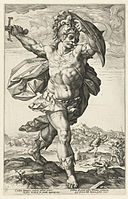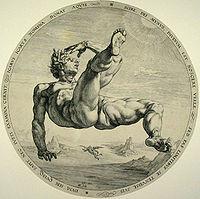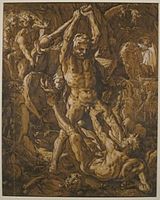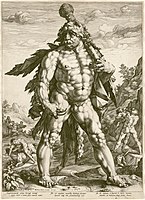art.wikisort.org - Artist
Hendrick Goltzius, or Hendrik, (German: [ˈgɔltsi̯ʊs]; Dutch: [ˈɣɔltsʲiœs]; January or February 1558 – 1 January 1617) was a German-born Dutch printmaker, draftsman, and painter. He was the leading Dutch engraver of the early Baroque period, or Northern Mannerism, lauded for his sophisticated technique, technical mastership and "exuberance" of his compositions. According to A. Hyatt Mayor, Goltzius "was the last professional engraver who drew with the authority of a good painter and the last who invented many pictures for others to copy".[1] In the middle of his life he also began to produce paintings.
Hendrick Goltzius | |
|---|---|
 Self-portrait (c. 1593–94) | |
| Born | Hendrick Goltz January/February 1558 Bracht, Duchy of Jülich, Holy Roman Empire |
| Died | 1 January 1617 (aged 58–59) Haarlem, Dutch Republic |
| Occupation | Printmaker, draftsman, painter |
| Known for | Use of the burin tool for engraving |
| Style | Northern Mannerism |
Biography


![Print reflecting an allegoric representation of wealth and industry.[2]](http://upload.wikimedia.org/wikipedia/commons/thumb/9/99/Allegorische_voorstelling_van_de_rijkdom_en_de_vlijt.jpg/220px-Allegorische_voorstelling_van_de_rijkdom_en_de_vlijt.jpg)
Goltzius was born near Venlo in Bracht or Millebrecht, a village then in the Duchy of Julich, now in the municipality Brüggen in North Rhine-Westphalia. His family moved to Duisburg when he was 3 years old. After studying painting on glass for some years under his father, he learned engraving from the Dutch polymath Dirck Volckertszoon Coornhert, who then lived in Cleves. In 1577 he moved with Coornhert to Haarlem in the Dutch Republic, where he remained based for the rest of his life. In the same town, he was also employed by Philip Galle to engrave a set of prints of the history of Lucretia.
Goltzius had a malformed right hand from a fire when he was a baby (his drawing of it is below), which turned out to be especially well-suited to holding the burin; "by being forced to draw with the large muscles of his arm and shoulder, he mastered a commanding swing of line".[3]
In the 1580s, Goltzius with his friends van Mander and the painter Cornelis van Haarlem, founded an art academy in Haarlem in emulation of those in France and Bologna, where the human figure could be studied from life and to provide a meeting-place for artists to discuss both practice and aesthetics.[4]
At the age of 21 he married a widow eight or nine years his senior, whose money enabled him to establish an independent business at Haarlem; but his unpleasant relations with her so affected his health that he found it advisable in 1590 to make a tour through Germany to Italy, where he acquired an intense admiration for the works of Michelangelo. He returned to Haarlem in August 1591, considerably improved in health, and worked there until his death.
His portraits, though mostly miniatures, are masterpieces of their kind, both on account of their exquisite finish, and as fine studies of individual character. Of his larger heads, his life-size self-portrait is probably the most striking example.
Goltzius brought to an unprecedented level the use of the "swelling line", where the burin is manipulated to make lines thicker or thinner to create a tonal effect from a distance. He also was a pioneer of "dot and lozenge" technique, where dots are placed in the middle of lozenge shaped spaces created by cross-hatching to further refine tonal shading.
Hollstein credits 388 prints to him, with a further 574 by other printmakers after his designs.
In his command of the burin, Goltzius is said to rival Dürer. He made engravings of Bartholomeus Spranger's paintings, thus increasing the fame of the latter – and his own. Goltzius began painting at the age of forty-two; some of his paintings can be found in Vienna. He also executed a few chiaroscuro woodcuts. He was the stepfather of engraver Jacob Matham. He died, aged 58, in Haarlem.
Public collections
Most major print rooms will have a group of Goltzius's many engravings.
- Museum Boijmans Van Beuningen, Rotterdam[5]
- Rijksmuseum Amsterdam[6]
- Blanton Museum of Art, Austin[7]
- University of Michigan Museum of Art, Ann Arbor[8]
- The Metropolitan Museum of Art, New York City[9]
- Philadelphia Museum of Art[10]
- British Museum, London[11]
- Los Angeles County Museum of Art[12]
- Fine Arts Museums of San Francisco[13]
Gallery
- Horatius Cocles, from The Roman Heroes, 1586
- Icarus (1588) from the series The four disgracers
- Engraving of the Farnese Hercules, c. 1598
- Sine Cerere et Baccho friget Venus (Without Ceres and Bacchus, Venus Would Freeze), 1600–03
- Portrait of the Shell Collector Jan Govertsen van der Aer (1603)
- Jupiter and Antiope (1612)
- The Fall of Man
- Hercules Killing Cacus, a chiaroscuro woodcut, 1588
- A Foxglove in Bloom, 1592, pen and brown ink on laid paper, National Gallery of Art, Washington, D.C.
- The Great Hercules, 1589
Notes
Citations
- Mayor (1971), no. 420
- "Allegorische voorstelling van de rijkdom en de vlijt". Ghent University Library. Retrieved 2 October 2020.
- Mayor (1971), no. 418. Other writers take his friend and biographer Karel van Mander's account to mean that he engraved with his right hand and drew with his left. See Melion, Walter S. (1991). Shaping the Netherlandish Canon: Karel Van Mander's Schilder-Boeck. University of Chicago Press. p. 59. ISBN 978-0-226519593 – via Google Books.
- Cohn, Marjorie B. (June 2014). "An Interpretation of Four Woodcut Landscapes by Hendrick Goltzius". Print Quarterly. XXXI (2): 149.
- "Collection: Hendrick Goltzius". Museum Boijmans Van Beuningen. Archived from the original on 22 March 2016. Retrieved 1 September 2014.
- "Hendrick Goltzius". Rijksmuseum.
- "Past Exhibitions, 2003: Prints from the Leo Steinberg Collection, Part 1". Blanton Museum of Art: The University of Texas at Austin. Archived from the original on 22 July 2015. Retrieved 17 July 2015.
- "Hendrick Goltzius". University of Michigan Museum of Art. Retrieved 12 January 2021.
- "Hendrick Goltzius (1558–1617)". Metropolitan Museum of Art. Retrieved 12 January 2021.
- "Collections Object : Landscape with a Waterfall". Philadelphia Museum of Art. Retrieved 12 January 2021.
- "Hendrik Goltzius". British Museum. Retrieved 12 January 2021.
- "Hendrik Goltzius". Los Angeles County Museum of Art. Retrieved 12 January 2021.
- "Hendrick Goltzius". Fine Arts Museums of San Francisco. 21 September 2018. Retrieved 12 January 2021.
References
- This article incorporates text from a publication now in the public domain: Chisholm, Hugh, ed. (1911). "Goltzius, Hendrik". Encyclopædia Britannica (11th ed.). Cambridge University Press.
- Mayor, A. Hyatt (1971). Prints and People: A Social History of Printed Pictures. New York City: Metropolitan Museum of Art. ISBN 0-691-00326-2.
- Cohn, Marjorie B. (June 2014). "An Interpretation of Four Woodcut Landscapes by Hendrick Goltzius". Print Quarterly. XXXI (2): 144–155.
Further reading
- Liedtke, Walter A. (1984). Flemish paintings in the Metropolitan Museum of Art. New York: The Metropolitan Museum of Art. ISBN 0870993569. (see index).
External links
- "Goltzius, Hendrick". Web Gallery of Art. Retrieved 19 August 2008.
- "Works on Hendrick Goltzius". PubHist.
- "Goltzius engravings: Metamorfosis". Coleccion de Verda.
- "Goltzius engravings: Apóstoles". Coleccion de Verda.
На других языках
[de] Hendrick Goltzius
Hendrick Goltzius (* Januar oder Februar 1558 in Bracht, heute Ortsteil von Brüggen im Kreis Viersen – bei Venlo; † 29. Dezember 1616 oder 1. Januar 1617 in Haarlem) war ein niederländischer Maler und Kupferstecher. Sein Werk ist dem Manierismus zuzuordnen.- [en] Hendrick Goltzius
[es] Hendrick Goltzius
Hendrick Goltzius (Bracht, cerca de Venlo, 1558 - Haarlem, 1617) fue un dibujante, grabador y pintor neerlandés. Considerado el mejor grabador de los Países Bajos del Manierismo nórdico, es reconocido por su técnica sofisticada y la «exuberancia» de sus composiciones. Según A. Hyatt Mayor, Goltzius «fue el último grabador profesional que dibujaba con la autoridad de un buen pintor y el último que inventó muchas imágenes para que otros las copiaran».[1] Ya a una edad madura, comenzó a producir pinturas.[fr] Hendrik Goltzius
Hendrik Goltz ou Hendrick Goltz, connu sous la forme latinisée de son nom, Goltzius (Bracht-am-Niederrhein - Venlo, janvier ou février 1558 – Haarlem, 1er janvier 1617), est un dessinateur, peintre et graveur néerlandais (Pays-Bas espagnols puis Provinces-Unies).[it] Hendrick Goltzius
Henrick Goltzius (Muhlbracht, gennaio o febbraio 1558 – Haarlem, 1º gennaio 1617) è stato un pittore e incisore olandese. È stato uno dei primi grandi incisori olandesi del primo periodo Barocco, conosciuto come Manierismo settentrionale, noto per una tecnica sofisticata e per "l'esuberanza" delle sue composizioni.[ru] Гольциус, Хендрик
Хендрик Гольциус (нидерл. Hendrick Goltzius, январь или февраль 1558, Брюгген, Северный Рейн-Вестфалия, или Лимбург — 1 января 1617, Харлем) — выдающийся художник нидерландского маньеризма, живописец, рисовальщик и гравёр, мастер резцовой гравюры на меди, один из основателей харлемской Академии художеств.Другой контент может иметь иную лицензию. Перед использованием материалов сайта WikiSort.org внимательно изучите правила лицензирования конкретных элементов наполнения сайта.
WikiSort.org - проект по пересортировке и дополнению контента Википедии









